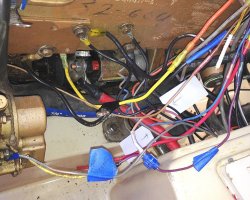Let me make sure I understand how to add a negative bus bar for the engine grounds to get them off the engine block. Maine Sail's instructions are here , under "All Cleaned Up." AS part of this project, I'm also jumping the alternator direct to the starter solenoid per Maine Sail.
Here's my current wiring. You can see several grounds are on rusty quarter inch studs on the block, with corroded wires and the wrong size ring terminals.

So
--Mount a heavy Blue Seas 4-post negative bus bar on the fiberglass engine stringer.
--Run a heavy cable from the alternator stud to the bus bar (using same stud as the new jumper to the starter)
--Run a cable from the starter mounting ear to the bus bar. What gauge wire?
--Relocate the existing 6(?) gauge negative battery cable* from the side of the block to the bus bar.
--Leave as is the heavy duty black cable* from the battery bank to the lower part of the block.
--Relocate the smaller grounds from block to bus bar after re-terminating them with correct ring connectors.
*these cables are hard to see, but have paper stickers on them in the photo .
Questions/Uncertainties are in bold.
Any confirmation or correction appreciated.
Here's my current wiring. You can see several grounds are on rusty quarter inch studs on the block, with corroded wires and the wrong size ring terminals.

So
--Mount a heavy Blue Seas 4-post negative bus bar on the fiberglass engine stringer.
--Run a heavy cable from the alternator stud to the bus bar (using same stud as the new jumper to the starter)
--Run a cable from the starter mounting ear to the bus bar. What gauge wire?
--Relocate the existing 6(?) gauge negative battery cable* from the side of the block to the bus bar.
--Leave as is the heavy duty black cable* from the battery bank to the lower part of the block.
--Relocate the smaller grounds from block to bus bar after re-terminating them with correct ring connectors.
*these cables are hard to see, but have paper stickers on them in the photo .
Questions/Uncertainties are in bold.
Any confirmation or correction appreciated.
Last edited:

